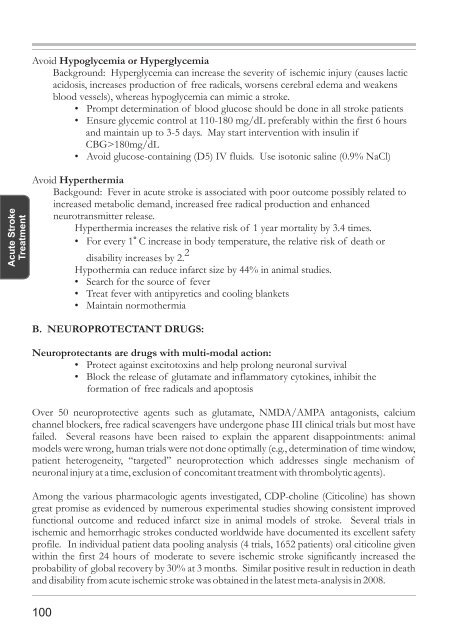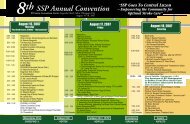Front Panel Painting “LIFE” By William T Chua MD
FREE download - Stroke Society of the Philippines
FREE download - Stroke Society of the Philippines
You also want an ePaper? Increase the reach of your titles
YUMPU automatically turns print PDFs into web optimized ePapers that Google loves.
Acute Stroke<br />
Treatment<br />
Avoid Hypoglycemia or Hyperglycemia<br />
Background: Hyperglycemia can increase the severity of ischemic injury (causes lactic<br />
acidosis, increases production of free radicals, worsens cerebral edema and weakens<br />
blood vessels), whereas hypoglycemia can mimic a stroke.<br />
• Prompt determination of blood glucose should be done in all stroke patients<br />
• Ensure glycemic control at 110-180 mg/dL preferably within the first 6 hours<br />
and maintain up to 3-5 days. May start intervention with insulin if<br />
CBG>180mg/dL<br />
• Avoid glucose-containing (D5) IV fluids. Use isotonic saline (0.9% NaCl)<br />
Avoid Hyperthermia<br />
Backgound: Fever in acute stroke is associated with poor outcome possibly related to<br />
increased metabolic demand, increased free radical production and enhanced<br />
neurotransmitter release.<br />
Hyperthermia increases the relative risk of 1 year mortality by 3.4 times.<br />
• For every 1°<br />
C increase in body temperature, the relative risk of death or<br />
disability increases by 2.<br />
2<br />
Hypothermia can reduce infarct size by 44% in animal studies.<br />
• Search for the source of fever<br />
• Treat fever with antipyretics and cooling blankets<br />
• Maintain normothermia<br />
B. NEUROPROTECTANT DRUGS:<br />
Neuroprotectants are drugs with multi-modal action:<br />
• Protect against excitotoxins and help prolong neuronal survival<br />
• Block the release of glutamate and inflammatory cytokines, inhibit the<br />
formation of free radicals and apoptosis<br />
Over 50 neuroprotective agents such as glutamate, N<strong>MD</strong>A/AMPA antagonists, calcium<br />
channel blockers, free radical scavengers have undergone phase III clinical trials but most have<br />
failed. Several reasons have been raised to explain the apparent disappointments: animal<br />
models were wrong, human trials were not done optimally (e.g., determination of time window,<br />
patient heterogeneity, “targeted” neuroprotection which addresses single mechanism of<br />
neuronal injury at a time, exclusion of concomitant treatment with thrombolytic agents).<br />
Among the various pharmacologic agents investigated, CDP-choline (Citicoline) has shown<br />
great promise as evidenced by numerous experimental studies showing consistent improved<br />
functional outcome and reduced infarct size in animal models of stroke. Several trials in<br />
ischemic and hemorrhagic strokes conducted worldwide have documented its excellent safety<br />
profile. In individual patient data pooling analysis (4 trials, 1652 patients) oral citicoline given<br />
within the first 24 hours of moderate to severe ischemic stroke significantly increased the<br />
probability of global recovery by 30% at 3 months. Similar positive result in reduction in death<br />
and disability from acute ischemic stroke was obtained in the latest meta-analysis in 2008.<br />
100



